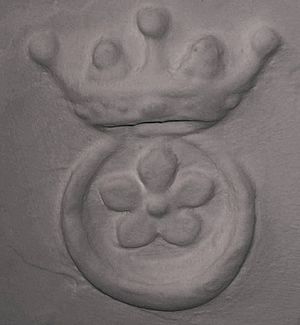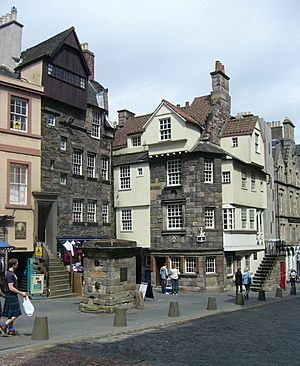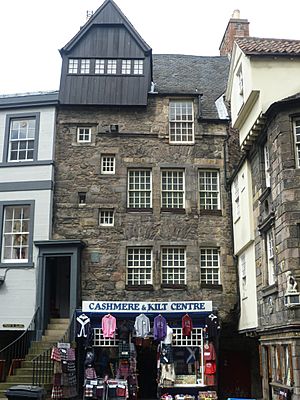Moubray House facts for kids
Moubray House, located at 51 and 53 High Street, is one of the oldest buildings on Edinburgh's famous Royal Mile. It's also one of the oldest homes in Edinburgh, Scotland, where people still live today! The front of the building you see now was built in the early 1600s, but its foundations were laid way back around 1477.
This historic building is special for its amazing interiors. Inside, you can find a beautiful Renaissance painted ceiling, discovered in 1999. There's also a plaster ceiling from 1650 with cool designs of fruit and flowers, and the family crest of the Pringles of Galashiels. The attic even has a unique wooden, barrel-shaped ceiling that you can see from the roof!
Many famous people have lived or worked here. These include George Jamesone, Scotland's first well-known portrait painter, and Daniel Defoe, an English writer and spy who helped with the 1707 Act of Union between Scotland and England. Archibald Constable, who owned the Encyclopædia Britannica, also had his shop here.
Moubray House is so important that Historic Scotland has made it a Category A listed building, meaning it's a building of special historical interest.
Contents
What is Moubray House Like?
Moubray House stands on the north side of the High Street. It's located between a narrow alleyway called Trunk's Close and the famous John Knox House. It's also very close to where the Netherbow Port used to be. This was the main gate into Edinburgh before it was taken down in 1764. Right outside the house, you can still see the Netherbow Well, which used to provide water for the Old Town.
This building is a rare survivor of a terrible event called the Burning of Edinburgh in 1544. During this time, King Henry VIII of England ordered his army to burn the city. In Trunk's Close, you can see strong stone supports that once held straight staircases. These stairs were part of a building from 1529. One of these stairs leads from a first-floor room where a beautiful painted ceiling from the late 1500s was found in 1999.
The Moubray Family History
The land where Moubray House stands belonged to the Turing family in 1369. Their name is still remembered in "Trunk's Close." The current building site was planned around 1472-1477. This was after the Netherbow Port (city gate) was rebuilt near "John Knox's House". Moubray House keeps the original line of the medieval High Street. It was the last house before the street narrowed defensively at the gate.
The building was known as Andrew Moubray's house in the 1500s. There were three different Andrew Moubrays! The back part of the house was likely built around 1529 by Andrew Moubray (III) and his wife, Katrine Hoppar. In old Edinburgh, plots of land were called "lands." Buildings could be divided into "fore, mid, and back-lands," and even into different floors. This made ownership quite complicated!
The Moubrays were a rich and important merchant family. They owned other properties in Edinburgh. Andrew Moubray (I) became a "burgess" (a citizen with special rights) of Edinburgh in 1451. In 1482, he was appointed "Customar of Edinburgh," which meant he collected royal taxes for the King. The family also bought land and supported a chaplain at St Giles Kirk.
The Moubrays mainly dealt with textiles. Andrew Moubray (II) even sold fine cloth to King James IV in 1496. He also traded wool, wine, and furs with other countries, like the Netherlands.
Andrew Moubray (II) married Jonet Halyburton. Her brothers were soldiers in the Garde Écossaise (a Scottish guard in France). When Andrew Moubray (II) died in 1499, his children were young. So, King James IV gave his property to a relative until they grew up. Andrew Moubray (III) later sold a crossbow to King James V in 1527.
Andrew Moubray (III) and the Hoppar Family
Andrew Moubray (III) married Katrine Hoppar. Her father, William Hoppar, was a merchant who supplied things for the royal family. Katrine's brother, Adam Hoppar, was the head of the Edinburgh Merchants Guild.
Katrine Hoppar also had a relative, Isobel Hoppar, who was a wealthy widow. Isobel later married Archibald Douglas of Kilspindie, a brother and advisor to the powerful Earl of Angus. For a time, they were given another property on the High Street. However, they lost this house when King James V became an adult and took back power from the Douglas family.
Andrew Moubray (III) also owned two properties across the street from Moubray House. In 1541, he traveled to Middelburg to arrange a trade agreement for Edinburgh. He was sent to Flanders again in 1544 to strengthen the friendship between Scotland and Flanders.
Andrew Moubray (III) died in Flanders in 1545. His wife, Katrine Hoppar (who died in 1551), continued to be involved in business. During a war called the Rough Wooing, she supplied iron for tools used by the Scottish army.
Robert Moubray, John Knox, and the Pringles
Robert Moubray, a son of Andrew (III) and Katrine Hoppar, inherited Moubray House when he was old enough. In the 1560s, Robert let another property he owned to the town council for the famous reformer John Knox to live in. This house was said to have a "warm study" for Knox to work in during the winter of 1561.
During the "Lang Siege" of Edinburgh Castle, when the castle bombarded the town, Robert Moubray and his family left Edinburgh for safety. They moved to Leith. After the siege, the town council allowed them to stay in Leith for the winter because Robert's wife, Janet Cant, was ill.
By 1592, James Hoppringle (or Pringle) and his wife Mariota Murray owned Moubray House. Their son, also named James Pringle, helped some schoolchildren who had been imprisoned. His son, another James Pringle, served in the Garde Écossaise (a Scottish guard in France) and married Sophia Schöner, whose father was the doctor for Anne of Denmark, the Queen.
Moubray House in the 1600s and 1700s

The stone front of Moubray House that faces the Royal Mile was built around 1630. Inside, on the second floor, there's a molded plaster ceiling from this time. It features the family symbol of the Setons (a crescent and a five-leaf shape) and royal symbols of England and Scotland. A painted Pringle family crest on the wall from 1650 might suggest that Jean Pringle of Galashiels lived here.
The famous painter George Jamesone lived in Moubray House. Later, in 1710, Daniel Defoe edited the Edinburgh Courant newspaper from the house. In the 1700s, the building even had a tavern! Until 1822, the shop on the street level was home to the publisher and bookseller Archibald Constable. He was known for owning the Scots Magazine, the Edinburgh Review, and the Encyclopædia Britannica. More recently, a publishing company called Moubray House Press was started here in 1984.
Restorations and Future Plans
Moubray House has been carefully restored several times. The Cockburn Association restored it in 1910, and architect Nicholas Groves-Raines worked on it in the 1970s. In the mid-1900s, it was the home and shop of an antiques dealer named Esta Henry.
More recently, an American supporter named Debra Stonecipher bought the different apartments in the house. She further restored it and then gave it to the nation in 2012. Now, Historic Scotland looks after this amazing historic building.
See also




